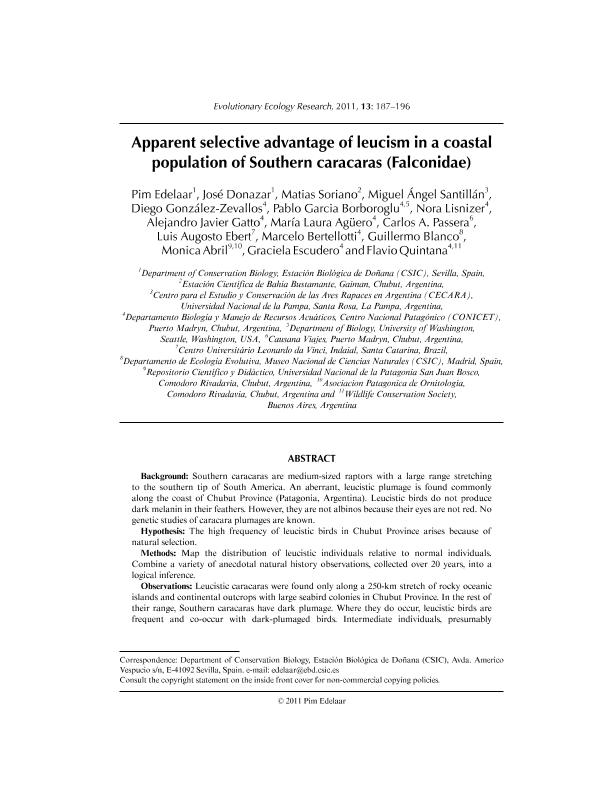Artículo
Apparent selective advantage of leucism in a coastal population of Southern caracaras (Falconidae)
Edelaar, Pim; Donazar, José; Soriano, Matías; Santillan, Miguel Angel; Gonzalez Zevallos, Diego Ricardo ; Garcia Borboroglu, Jorge Pablo
; Garcia Borboroglu, Jorge Pablo ; Lisnizer, Nora
; Lisnizer, Nora ; Gatto, Alejandro Javier
; Gatto, Alejandro Javier ; Agüero, Maria Laura
; Agüero, Maria Laura ; Passera, Carlos A.; Ebert, Luis Augusto; Bertellotti, Néstor Marcelo
; Passera, Carlos A.; Ebert, Luis Augusto; Bertellotti, Néstor Marcelo ; Blanco, Guillermo; Abril, Monica; Escudero, Graciela; Quintana, Flavio Roberto
; Blanco, Guillermo; Abril, Monica; Escudero, Graciela; Quintana, Flavio Roberto
 ; Garcia Borboroglu, Jorge Pablo
; Garcia Borboroglu, Jorge Pablo ; Lisnizer, Nora
; Lisnizer, Nora ; Gatto, Alejandro Javier
; Gatto, Alejandro Javier ; Agüero, Maria Laura
; Agüero, Maria Laura ; Passera, Carlos A.; Ebert, Luis Augusto; Bertellotti, Néstor Marcelo
; Passera, Carlos A.; Ebert, Luis Augusto; Bertellotti, Néstor Marcelo ; Blanco, Guillermo; Abril, Monica; Escudero, Graciela; Quintana, Flavio Roberto
; Blanco, Guillermo; Abril, Monica; Escudero, Graciela; Quintana, Flavio Roberto
Fecha de publicación:
05/2011
Editorial:
Evolutionary Ecology
Revista:
Evolutionary Ecology Research
ISSN:
1522-0613
Idioma:
Inglés
Tipo de recurso:
Artículo publicado
Clasificación temática:
Resumen
Background: Southern caracaras are medium-sized raptors with a large range stretching to the southern tip of South America. An aberrant, leucistic plumage is found commonly along the coast of Chubut Province (Patagonia, Argentina). Leucistic birds do not produce dark melanin in their feathers. However, they are not albinos because their eyes are not red. No genetic studies of caracara plumages are known. Hypothesis: The high frequency of leucistic birds in Chubut Province arises because of natural selection. Methods: Map the distribution of leucistic individuals relative to normal individuals. Combine a variety of anecdotal natural history observations, collected over 20 years, into a logical inference. Observations: Leucistic caracaras were found only along a 250-km stretch of rocky oceanic islands and continental outcrops with large seabird colonies in Chubut Province. In the rest of their range, Southern caracaras have dark plumage. Where they do occur, leucistic birds are frequent and co-occur with dark-plumaged birds. Intermediate individuals, presumably heterozygotes, exist. Leucism is not related to age or sex. Leucistic individuals are restricted to a particular habitat. Gene flow has not homogenized the coastal and inland populations. Results: Leucism is not simply due to inbreeding producing more homozygous individuals. Leucism is not due to genetic drift. Leucism is not an environmental effect on individual physiology or development. Leucism is not a transient (plastic) phenomenon. Where they occur frequently, leucistic Southern caracaras are apparently favoured by natural selection, either directly or by pleiotropy.
Palabras clave:
Southern Caracara
,
Leucistic Plumage
,
Patagonia
Archivos asociados
Licencia
Identificadores
Colecciones
Articulos(CCT-CENPAT)
Articulos de CTRO.CIENTIFICO TECNOL.CONICET - CENPAT
Articulos de CTRO.CIENTIFICO TECNOL.CONICET - CENPAT
Citación
Edelaar, Pim; Donazar, José; Soriano, Matías; Santillan, Miguel Angel; Gonzalez Zevallos, Diego Ricardo; et al.; Apparent selective advantage of leucism in a coastal population of Southern caracaras (Falconidae); Evolutionary Ecology; Evolutionary Ecology Research; 13; 5-2011; 187-196
Compartir



